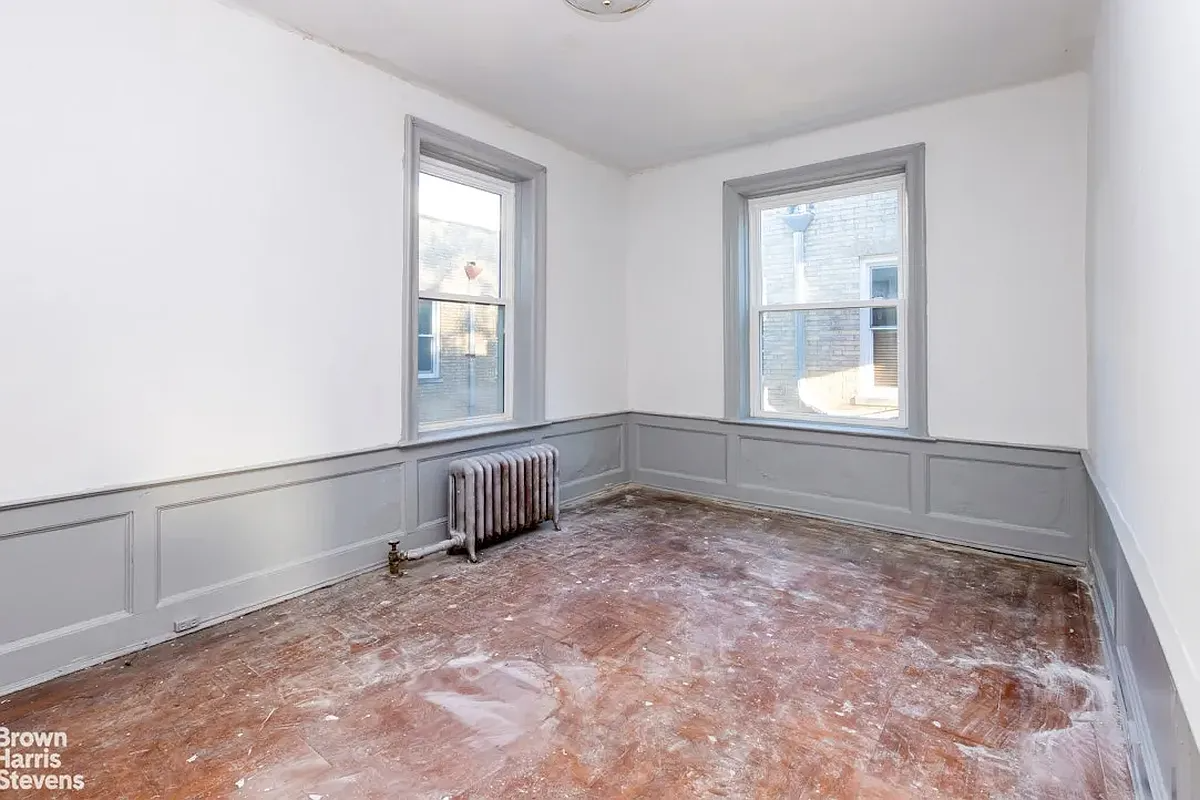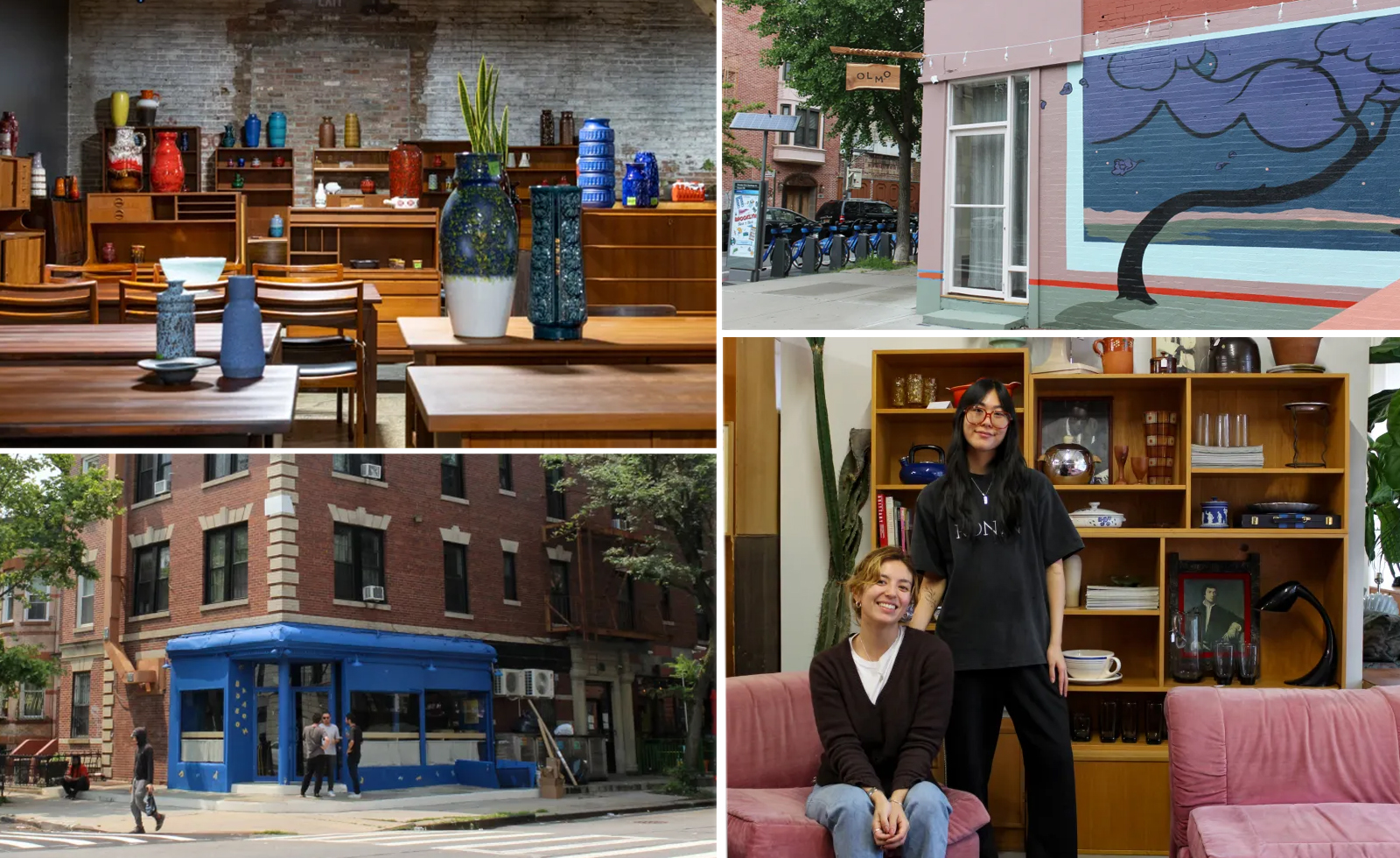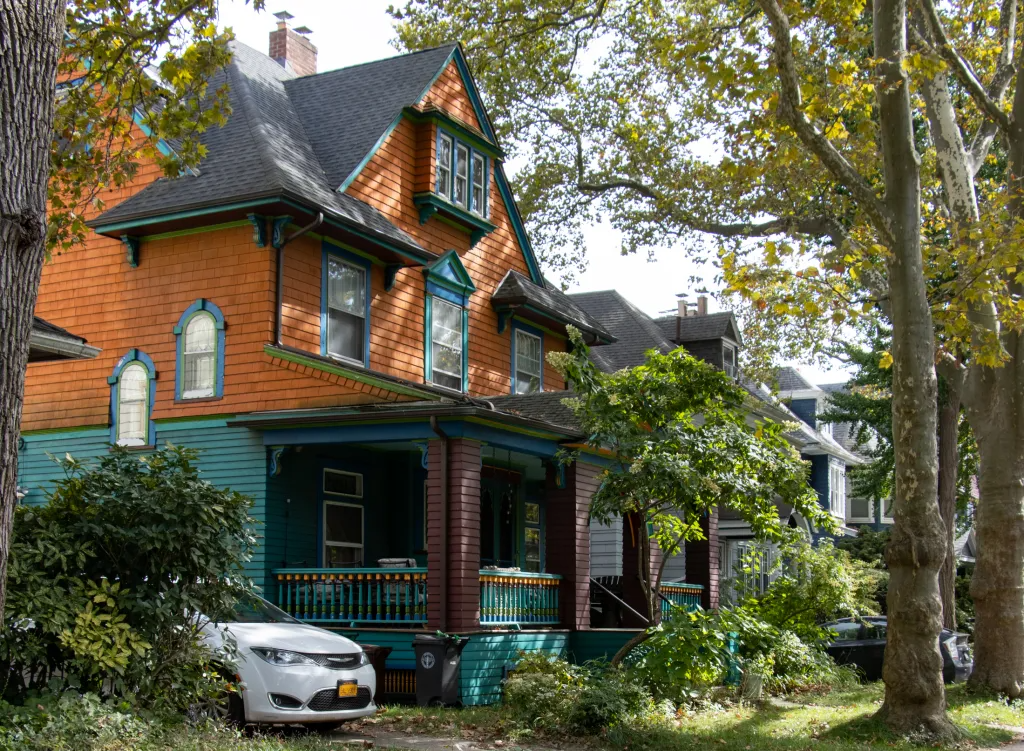They Live Below Sea Level in NYC. Now, the City Could Buy Out ‘The Hole’
The low-lying neighborhood on the Brooklyn-Queens border will be the first place in New York where officials may buy properties proactively.

Julisa Rodriguez and one of her children at their home in ‘The Hole,’ a below-sea-level neighborhood, October 2, 2025. Photo by Alex Krales/THE CITY
by Samantha Maldonado
This article was originally published on October 3 at 5 a.m. EDT by THE CITY
For decades, residents of a neighborhood that straddles the border of Brooklyn and Queens have dealt with the unique effects of living in a basin: swampy flooding, bumpy streets, overgrown lots strewn with trash and leaky septic tanks — because homes are not connected to the city sewer system.
With roads named for Amber, Sapphire, Ruby and Emerald, what some locals call the Jewel Streets area may be better known as The Hole. It’s a neighborhood unlike any other.
And it is now unique in another way: It’s becoming the first place in the five boroughs where the New York City government will offer to buy flood-prone homes from homeowners — proactively, instead of in response to a disaster.
The Mayor’s Office of Climate and Environmental Justice on Friday will begin collecting information from homeowners possibly interested in the city purchasing their property, including one- to four-unit homes and vacant lots.
For some locals, the possibility of selling their homes and no longer dealing with the conditions in the neighborhood comes as a relief.
“I’ve had enough,” said Bart Aclin, a retired Fire Department inspector who has owned his home there for nearly 25 years. “I’d rather just sell the property, if they give us fair market value, what they claim the property is worth. We’ll see.”

Under the shadow of leafy trees, Aclin’s home is at one of the lowest points in the neighborhood. He loves the quiet seclusion. He has an above-ground pool in the backyard, and he feeds four stray cats daily. But even on a dry autumn day this week, pumps continually moved water from his permanently soggy basement through a tangle of hoses into the overgrown lot next door.
“I don’t really want to leave, but it’s getting to that point,” Aclin said.
While homeowners can raise their hands for a possible offer from the city, there’s no guarantee it’ll come through. The city will consider if the property could fulfill a particular use in the context of new development and drainage upgrades in the neighborhood. For instance, the city could turn the land into park space or a community garden, put pumps or stormwater storage systems on it, or build new, flood-resilient housing.
The Resilient Acquisitions program, as the new effort is called, is intended to be “a resilience strategy that preserves as much housing as possible and ideally expands it by using properties that are acquired to defend other parts of their neighborhood,” said Department of Environmental Protection Commissioner Rohit Aggarwala.
Moving On
Acquiring property like the city is proposing in The Hole is a type of climate change adaptation known as managed retreat, where people, buildings, and equipment move away from flood risks. But with the city’s housing crisis, taking places to live out of service is a thorny endeavor, and can have ripple effects throughout longstanding communities.
“We’ve designed a program that does really allow for us to have the targeted and necessary community conversation acquiring homes around flooding,” said Paul Lozito, deputy executive director of the Mayor’s Office of Climate and Environmental Justice.

After interested homeowners submit a form to the city, they can expect to get a call back in about two weeks’ time, he said. Then various agencies will talk to each other as well as to local individuals and community groups about uses for the land. Once the city decides what can be done with the property, homeowners can formally apply to sell their homes or lots.
Case managers will work with both property owners and tenants living in the buildings to help them move.
Making It Work
The Hole, sandwiched between East New York, Brooklyn, and Lindenwood, Queens, was built on top of marshland and has long dealt with neglect.
Even drizzles could cause standing puddles in the middle of streets, which attracted mosquitoes and made getting around difficult. Many homes aren’t hooked up to the city sewer system and rely on septic tanks, which also overflow when it rains. Floodwaters have at times seeped into or frozen gas lines, cutting off heat to homes.
Residents took matters into their own hands. They jerry-rigged a series of makeshift pumps to get water out of the street, and in some places, paved their own sidewalks. They invested tens of thousands of dollars in their homes to create protection from floods, and repair things when the water comes.

Some homeowners like Julisa Rodriguez have been advocating for many years for the city to buy them out. Now that that could happen, she’s both excited and a bit sad when she considers the uncertainty ahead.
“It’s a lot to think about. It’s really a lot,” she said. “I was surprised myself. I thought, ‘Aren’t you supposed to be happy, jumping through the roof?’”
Rodriguez said she’d have to figure out where to move, keeping in mind the schooling of her two kids, ages 5 and 10. On a recent sunny afternoon, they rode their bikes and played basketball in the front yard. Rodriguez called the area her oasis.
But she’s haunted by a memory from a decade ago of being pregnant with her son and the first floor flooding so badly she had to decamp to a hotel and then renovate. She said she recently got her house appraised and learned it was worth $1.3 million. How much the city can offer will determine her next steps, she said.
“I’m hoping that the city is fair and just. I think we do deserve it,” she said.

Floating Hope
The new program is designed to cope with not just coastal flooding — water that comes from the ocean or bays during storms, which New York saw during Superstorm Sandy — but stormwater flooding, too, or what happens when the skies open up.
The environmental protection agency singled out the Jewel Streets area as one of 86 places in the city that need significant interventions because of stormwater flooding. And they came up with several ideas to fix it over the years.
The agency considered redoing the entire neighborhood’s sewer system, and connecting it to the rest of the city, but that would mean elevating streets up so high that they would bury the front doors of some homes. The city has also floated building a bluebelt — an engineered enhancement of a natural watershed to store and channel stormwaters — but would need more property to do so.
The city’s Housing Preservation and Development agency is working to create a neighborhood plan for the 12 blocks of the Jewel Streets area, as well as the surrounding, wider area that’s wedged between Conduit Avenue and Shore Parkway.
Along with other agencies — including the transportation and sanitation departments — the plan aims to better connect the streets, reduce flooding, and develop new housing and open space. Already, agencies have cleaned up refuse that was dumped in some empty lots and began towing abandoned cars. The DEP in 2023 installed new storm sewers and catch basins, which residents said helped to cut down on the standing water.
While the acquisition program is limited to the Jewel Streets area for now, it may expand to other flood-prone neighborhoods as funding becomes available. The city will choose the areas based on where other strategies for preventing or protecting against flooding aren’t physically or financially feasible.

The Adams administration had proposed exploring an acquisition program for flood-prone properties in 2023 as part of the annual citywide sustainability report. That idea was built upon work from the de Blasio administration, which floated buying up properties soon after the floodwaters of 2021’s Hurricane Ida ravaged several low-lying neighborhoods. Some residents of repeatedly deluged homes in Hollis, Queens, asked the city for buyouts, but have never seen offers.
The government has bought out homes in flooded neighborhoods before, but all were done in response to Hurricane Sandy. And they were limited to certain coastal neighborhoods in Queens — including Edgemere on the Rockaway Peninsula — and in Staten Island, including in Midland Beach and Oakwood Beach.
That the Jewel Streets area would be the focus of the city’s first proactive buyout program was “awesome,” said Debra Ack, a member and co-founder of the East New York Community Land Trust, a community group that has been working with the residents since 2021 to push for improvements.
Ack was in a working group convened in 2023 to figure out how a buyout program could be part of the city’s strategy to become “rainproof,” and pushed for the neighborhood to be considered.
“This way you can condemn the land, make it undevelopable, and put some nature back there,” Ack said. “It will still take time. At least we know it’s in the works, it’s doable now. The change is really happening for the Jewel Streets.”
Related Stories
- Climate Report Predicts NYC’s Future Will Include Extreme Heat and Rain
- Long-Awaited Red Hook Coastal Resiliency Project Kicks Off With Groundbreaking
- Noxious Columbia Waterfront Concrete Recycling Facility to Close
Email tips@brownstoner.com with further comments, questions or tips. Follow Brownstoner on X and Instagram, and like us on Facebook.





What's Your Take? Leave a Comment